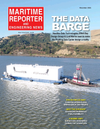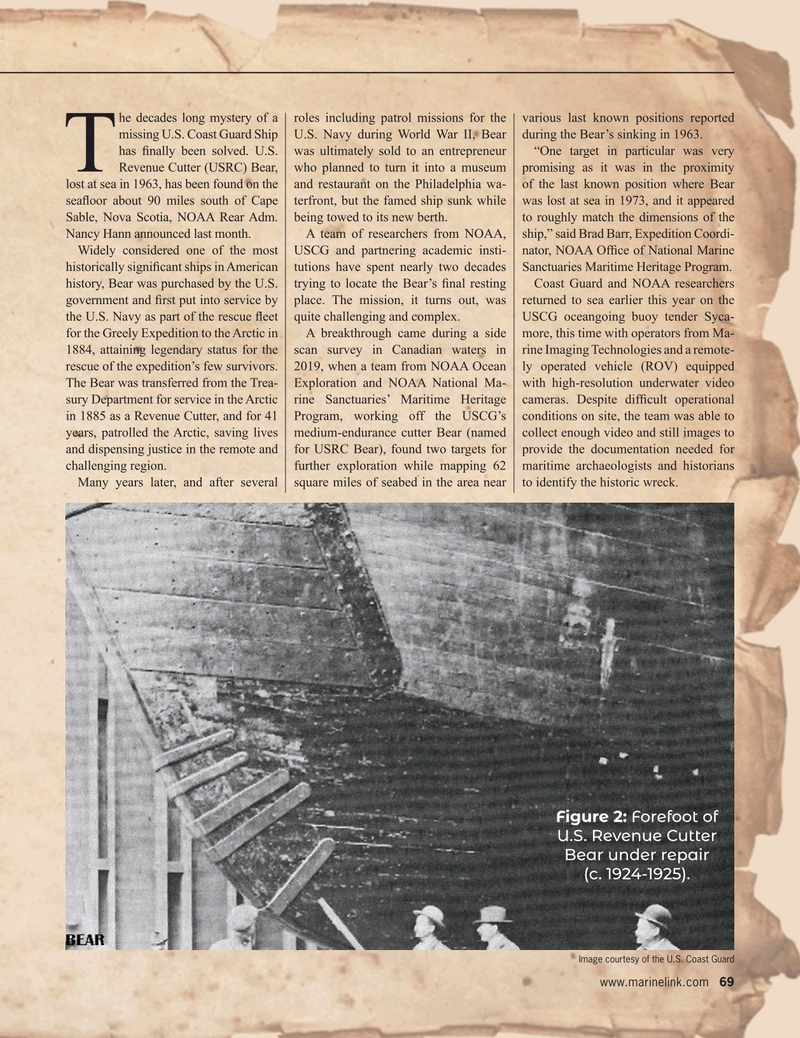
Page 69: of Maritime Reporter Magazine (November 2021)
The Workboat Edition
Read this page in Pdf, Flash or Html5 edition of November 2021 Maritime Reporter Magazine
he decades long mystery of a roles including patrol missions for the various last known positions reported missing U.S. Coast Guard Ship U.S. Navy during World War II, Bear during the Bear’s sinking in 1963.
has ? nally been solved. U.S. was ultimately sold to an entrepreneur “One target in particular was very
T Revenue Cutter (USRC) Bear, who planned to turn it into a museum promising as it was in the proximity lost at sea in 1963, has been found on the and restaurant on the Philadelphia wa- of the last known position where Bear sea? oor about 90 miles south of Cape terfront, but the famed ship sunk while was lost at sea in 1973, and it appeared
Sable, Nova Scotia, NOAA Rear Adm. being towed to its new berth. to roughly match the dimensions of the
Nancy Hann announced last month. A team of researchers from NOAA, ship,” said Brad Barr, Expedition Coordi-
Widely considered one of the most USCG and partnering academic insti- nator, NOAA Of? ce of National Marine historically signi? cant ships in American tutions have spent nearly two decades Sanctuaries Maritime Heritage Program.
history, Bear was purchased by the U.S. trying to locate the Bear’s ? nal resting Coast Guard and NOAA researchers government and ? rst put into service by place. The mission, it turns out, was returned to sea earlier this year on the the U.S. Navy as part of the rescue ? eet quite challenging and complex. USCG oceangoing buoy tender Syca- for the Greely Expedition to the Arctic in A breakthrough came during a side more, this time with operators from Ma- 1884, attaining legendary status for the scan survey in Canadian waters in rine Imaging Technologies and a remote- rescue of the expedition’s few survivors. 2019, when a team from NOAA Ocean ly operated vehicle (ROV) equipped
The Bear was transferred from the Trea- Exploration and NOAA National Ma- with high-resolution underwater video sury Department for service in the Arctic rine Sanctuaries’ Maritime Heritage cameras. Despite dif? cult operational in 1885 as a Revenue Cutter, and for 41 Program, working off the USCG’s conditions on site, the team was able to years, patrolled the Arctic, saving lives medium-endurance cutter Bear (named collect enough video and still images to and dispensing justice in the remote and for USRC Bear), found two targets for provide the documentation needed for challenging region. further exploration while mapping 62 maritime archaeologists and historians
Many years later, and after several square miles of seabed in the area near to identify the historic wreck.
Figure 2: Forefoot of
U.S. Revenue Cutter
Bear under repair (c. 1924-1925).
Image courtesy of the U.S. Coast Guard www.marinelink.com 69
MR #11 (66-74).indd 69 11/5/2021 11:20:15 AM

 68
68

 70
70
